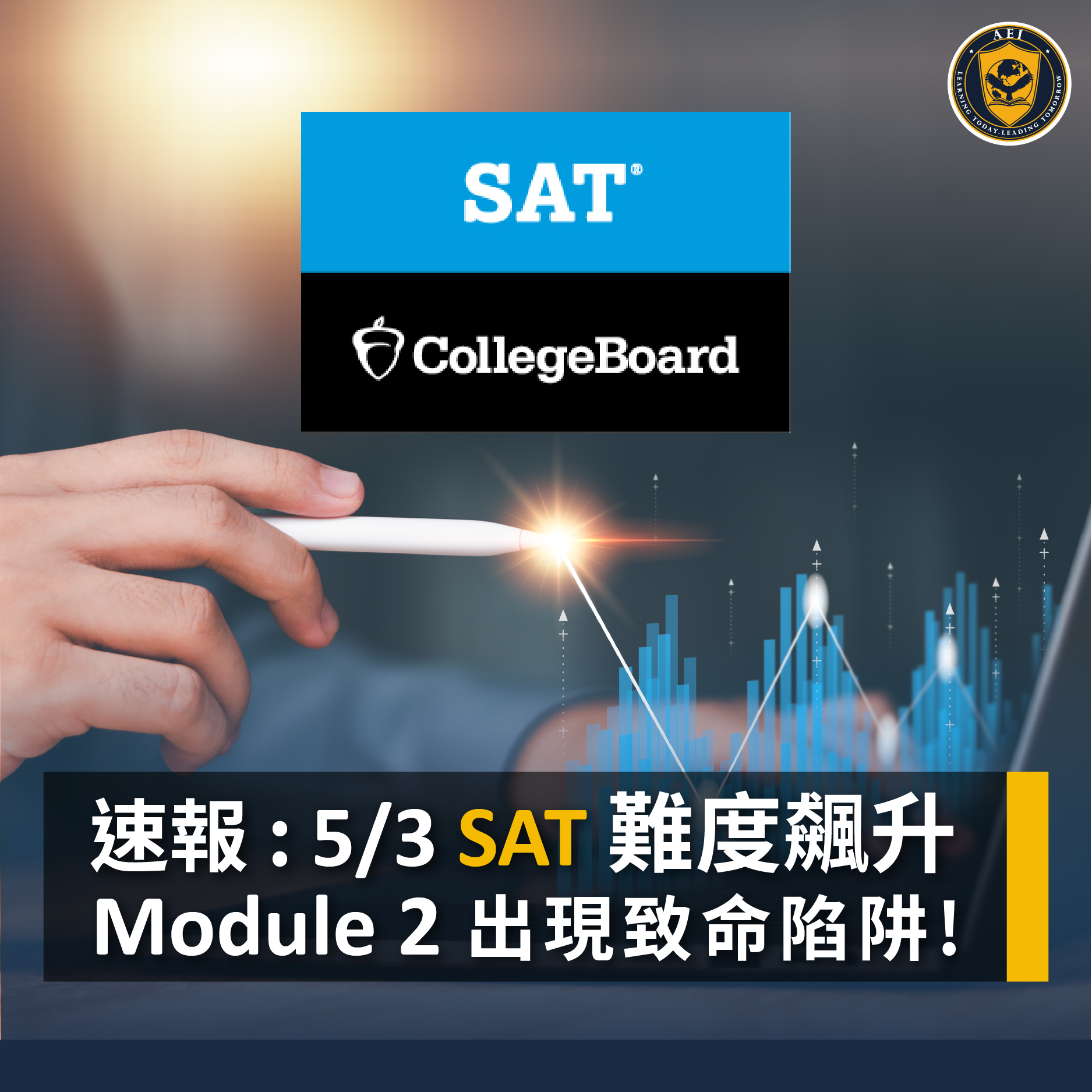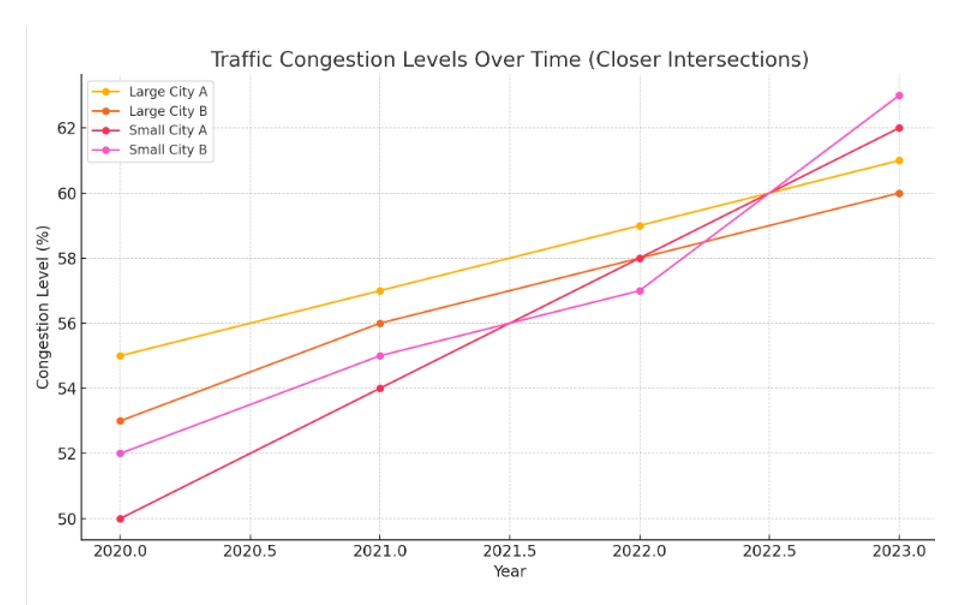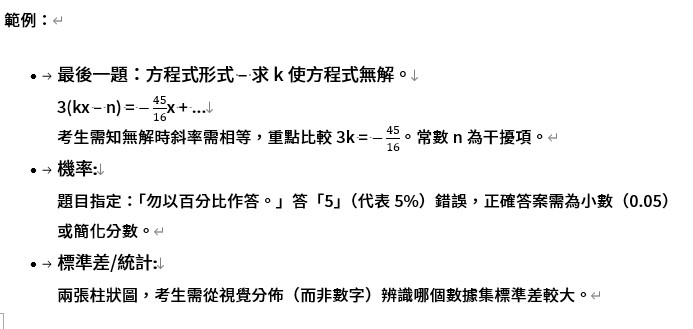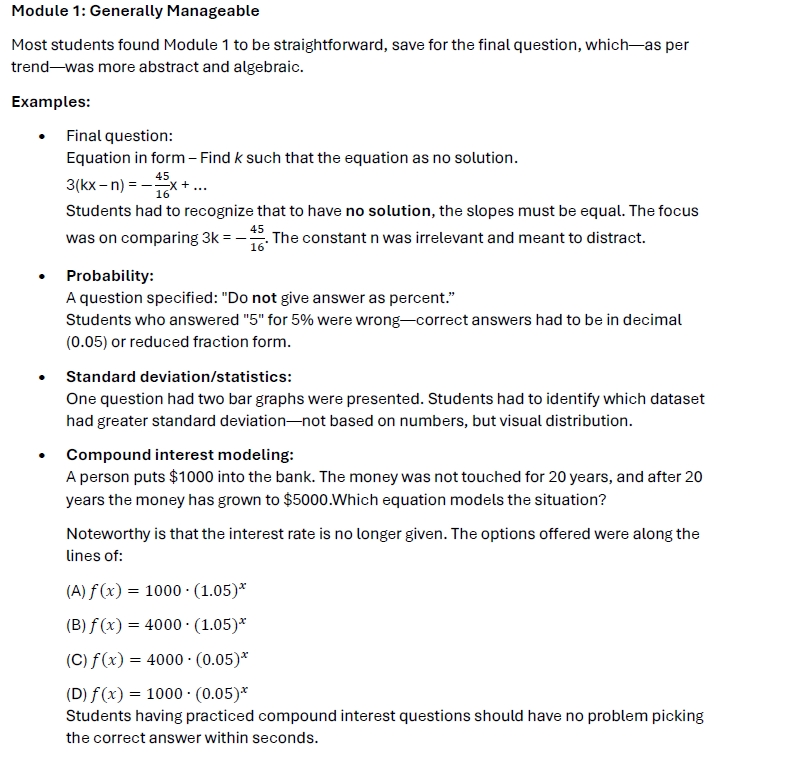
📝 2025年5月3日 SAT 考試解密
本次 SAT 延續近期的命題趨勢:開頭題目相對友善,結構安排熟悉,但在英文與數學模組後段皆出現難度提升的現象。此外,部分題型也出現具有挑戰性的變化,值得考生特別留意。以下為本次試題的重點整理與分析,提供給未來考生作為準備參考。
📖 閱讀與寫作(Reading and Writing)
Module 1: Straightforward Start, Familiar Structure
有些同學表示本模組開頭題目極為簡單,甚至是「重出」的內容。第一題如下:
“Pops, I’m here!” I drop my bag and set my guitar case against a wall…
問題:在這個語境中 “drop” 是什麼意思?
正確答案:放下(put down)。
儘管開場簡單,但學生不可掉以輕心。早期出現的一道題為雙篇閱讀題,需要學生精準抓出兩者核心觀點的差異——這類題雖常見,但關鍵在於能否快速又清楚地辨識並表達不同立場。
如預期,模組一的修辭合成(rhetorical synthesis)難度並不高,許多題目甚至沒有出現典型句型「學生在研究時做了以下筆記……」,但仍要求學生依照題目指定目的,選出最適合的句子。詞彙部分也相對容易。
觀察重點:
- 轉折語:考查「on the contrary」、「in contrast」、「as a result」、「specifically」等詞語,須先釐清句意關係。
- 分號使用:再次出現用分號分隔長列表的題型,考基本標點知識。
- 動詞與動名詞/分詞區分:此類題型要求學生能辨識一段列舉是否為同一語法結構的成分。
- 動詞時態與主詞一致:例如下列句型:
What the author did not expect from the book, <非必要子句>, ___
這類問題需懂得「What」引導的名詞子句為單數主詞,並能排除修飾子句找主詞。
模組 2:詞彙難度上升,分析要求更高
與第一模組相比,第二模組的整體難度有所提升。詞彙選項更具挑戰性,而過渡語與修辭題雖篇幅精簡,但需要考生更細緻地理解上下文邏輯,才能正確作答。
- 本次值得注意的詞彙包含:Expendable – 常見詞彙,但可能與「expandable」混淆。意為「不重要,可丟棄」。若看過《The Expendables》系列,可能已熟悉。
- Fecundity – 較難詞彙,意為「生育力」。
- Supplant – 我們很高興與大家分享這是我們PSAT Junior Spring教材中的詞彙,適合七年級學生。SAT詞彙需長期累積,及早開始累計有益。
- Ubiquitous 頻繁出現,意為「無處不在」或「常見」,值得熟記。
篇章與重複主題
馬修・阿諾德 1869 年所著《文化與無政府狀態》(Culture and Anarchy)再次登場!雖然使用的是過去出現過的文本,但題目設計為全新內容,顯示出 College Board 著重測驗學生的理解力,而非單純記憶。以下為本次相關文本與練習題參考:
In the same way the Times replying to some foreign strictures on the dress, looks, and behaviour of the English abroad, urges that the English ideal is that everyone should be free to do and to look just as he likes. But culture indefatigably tries, not to make what each raw person may like, the rule by which he fashions himself; but to draw ever nearer to a sense of what is indeed beautiful, graceful, and becoming, and to get the raw person to like that.
What is the main idea of the text?
- Shakespeare’s The Winter’s Tale 用於測試解釋與推論能力。理解古老語法與戲劇情境至關重要。測試部分為較古老的英語,可能令考生感到壓力。參考文本與問題如下:
OLIXENES I pray thee, good Camillo, be no more
importunate. ’Tis a sickness denying thee anything,
a death to grant this.
CAMILLO It is fifteen years since I saw my country.
5 Though I have for the most part been aired abroad,
I desire to lay my bones there. Besides, the penitent
king, my master, hath sent for me, to whose feeling
sorrows I might be some allay—or I o’erween to
think so—which is another spur to my departure.
What is the purpose of the underlined portion of the text?
圖表閱讀問題:
- 一題涉及果蠅、氣候、壽命與翅展。圖表題常包含干擾資訊,考生需辨識哪個數據模式最佳支持指定論點——需比較不同月份與特徵。論點為:較冷的氣候下,果蠅壽命較短與體型較小相關。最佳證據需比較翅展與壽命,例如顯示較冷月份(如10月)翅展較小、壽命較短,對比較暖月份(如7月)翅展較大、壽命較長。
- 另一題涉及城市交通擁堵。四個城市——兩個大城市、兩個小城市——擁堵水平均呈上升趨勢,大城市擁堵水平高於小城市。論點為:無論城市大小,交通擁堵均惡化。最佳支持陳述比較一大一小城市,顯示兩者擁堵水平均增加。僅陳述擁堵事實而不比較,無法支持論點,因缺乏跨城市規模的趨勢證據。

僅供示意之圖表
正確答案往往是語句最簡潔、看似最無關的一個,因為它通常準確地改寫了文本中的核心概念。相對地,其他選項可能包含原文中的關鍵詞或數據,但往往存在理解錯誤或語意偏差,因此不正確。
論點/支持問題:
以往題目通常分為兩大類:
- 針對文學文本提出論點並尋找證據支持
- 科學類閱讀
但現在出現更多跨領域題型。例如在非科學情境中(如探討個人信念),題目會詢問哪一項「發現」可能挑戰某個論點(過去常用的問法是「削弱」該論點)。這類題目強調學生對證據的理解與推理能力,這項能力仍是解題關鍵。
語法趨勢:
- 包含逗號的插入破折號。例如:
A recent study on the techniques used by the artist – often imitated by contemporaries because the work is very sought after,*** as one piece recently sold for 1 million – revealed that it may be AI generated.
這題屬於標點邏輯題,考察的是破折號應放置的位置。重點在於判斷破折號應該放在「as one piece」之前,還是維持在原句中的位置。部分選項甚至直接省略破折號,增加判斷難度。若考生錯誤地將破折號移至「as one piece」前並刪除,整句將變成:
A recent study on the technique used by the artist as one piece …
語法錯誤。
題目字數縮短:多為單句問法,考生需更迅速、準確地判斷句子的語法結構與功能。此類題型干擾選項較少,整體難度相對較低。
📐 数学
模組1:還可以

- 複利模型:
某人存$1000,20年未動,成長至$5000。哪個方程式模擬此情境?有趣的是題目未提供利率,選項為:

熟悉複利者可迅速選出正確答案。
Module 2: 高度抽象且非直觀
本模組整體難度明顯上升,較 3 月場次更具挑戰性。即使是對數學有自信的學生,也普遍反映題目不易。雖然難度未達 AMC 等級,但因時間限制或題目表述較為複雜,仍造成不少壓力。一旦無法迅速掌握解題方向,往往會花費過多時間,影響後續答題節奏。
值得注意的難題:
- 函數增長率比較
Question:
問題:「若x增加c單位,輸出增加27。哪個函數的1/c體現在其係數中?」
我們熟悉的「體現在係數中」題目再次出現。選項包含根、指數及嵌套函數中的冪。需理解函數如何縮放與轉換——非記憶,而是壓力下的推理。
- 幾何/表面積:
給長方錐底面尺寸與垂直高度,求表面積。底面為長方形,需用勾股定理計算兩個斜高。誤讀斜高與垂直高度會導致錯誤。
- 物理應用:
半徑3、密度0.75的球,求質量? 需回想球體積公式(公式表可查)並應用密度=質量/體積。計算得2700π 。
- 進階二次方程運算:
給兩多項式:
x² + 8x + 14 → 根j, k且j<k
x² + 8x + 8 → → 根m, n且m<n
新多項式根為j+n及k+n,求此二次方程的常數項? 題目不難,但若未辨識考點,耗時長。根為無理數,j+n及m+k可能混淆。高端破解法為使用根和操作及Vieta公式。
座標幾何
三角形題給座標平面上一線段,為三角形一邊,面積給定。需計算線段長度,用面積公式A = 0.5 b*h求另一邊長度。
- 情境數學陷阱題
三角形XYZ,X為直角,W在YZ上,XW垂直於YZ。若WX=556,YW=417,求tan(Z)。
解法:需畫圖,辨識YW與WX構成tan(Y),計算arctan(417/556)得Y。高階學生可直接輸入tan(90 – arctan(417/556))得4/3。
- 「A與B項目」總成本變化:
未直接給單位價格,給15個單位的總價,需反推單價。標準代數題的變形。
📌 整體趨勢與要點
- 重複篇章使用增加
常見文本再度登場,馬修・阿諾德的《文化與無政府狀態》已是第三次出現在考題中,莎士比亞文本也再次入題,顯示出 SAT 趨勢傾向重複使用基礎文本,但搭配不同題目設計。這類安排著重考察學生對內容的理解與熟悉程度,而非單純記憶。 - 數學概念穩定,措辭更難
數學內容多在Bluebook範圍內,但問題呈現更複雜。考生需:- 仔細閱讀,
- 理解如「增加c單位」或「基於生產的收入差異」等措辭,
- 掌握函數行為與轉換。
- 閱讀技能跨領域
圖表判讀、觀點改寫,以及支持/削弱論點的題型,不再只出現在科學類文章中,如今也常見於文學或意見類內容。這反映出 SAT 正積極推動跨領域推理能力的培養與測驗。 - 詞彙難度回歸
第二模組出現fecundity与supplant,顯示高階詞彙仍為考試一部分,特別在進階模組。
🎯 未來考生建議
- 理解大於記憶
考題不再只要求背誦公式,而是重視學生是否能解釋函數的行為,並預測輸入改變如何影響輸出。 - 精讀修辭與過渡詞題
這類題目越來越細緻,判斷句子邏輯與銜接關係的能力成為答題關鍵。 - 練習圖表解讀技巧
無論是數學還是英文模組,圖表資訊的判讀與比較都是核心能力,特別是簡單圖表背後的細節分析。 - 善用 Desmos(內建圖形計算器)
部分題目可藉由圖形視覺快速解題,但仍須具備代數運算與解析能力,避免過度仰賴工具。 - 模擬實戰壓力
數學第二模組大約從第 7 題開始難度顯著上升,建議學生在練習時預設較早面對高難度題目,以調整解題節奏與心理狀態。
📝 In-Depth Analysis: May 3, 2025 SAT Exam
The May 3rd SAT continued many of the trends seen in recent test cycles—accessible openings, familiar structures, and increased difficulty in later modules—while adding a few challenging twists in both the English and Math sections. Here’s an in-depth breakdown of what students encountered and what future test-takers should prepare for.
📖 Reading and Writing
Module 1: Straightforward Start, Familiar Structure
For some, the first module opened with what many considered a “recycled” easy passage. The first question was:
“Pops, I’m here!” I drop my bag and set my guitar case against a wall…
Question: What does “drop” mean in this context?
Answer: Put down.
While the content was approachable, students shouldn’t relax too quickly. One of the early questions was a paired-passage comparison where students needed to pinpoint the core difference between two perspectives—standard fare, but the key was knowing how to locate and articulate differing viewpoints concisely.
As expected, rhetorical synthesis questions were not particularly challenging in Module 1. Many didn’t even include the typical phrasing like “While doing research, a student has taken the following notes…””—but still required identifying the sentence that best serves the purpose specified by the question. Vocabulary remained mostly approachable in this module.
Key Observations:
- Transitions tested: On the contrary, in contrast, as a result, specifically, etc. Students needed to identify how two ideas relate before selecting the correct transition.
- Semicolon usage: Lists separated by semicolons returned again—requiring students to know when commas are insufficient.
- Distinguishing between verbs, gerunds, and participles. This type of question requires students to identify a list is being introduced, and which clauses make up one constituent of the list.
- Verb tense: Recognizing noun clauses as singular subjects. For example, the question observed had the form:
What the author did not expect from the book, <nonessential clause>, _(verb) _ ….
It is important to be able to remove unessential clauses and understand that “What” is a noun clause which is singular.
Module 2: More Challenging Vocabulary, Deeper Analysis
Compared to Module 1, Module 2 raised the stakes. Vocabulary difficulty increased, and while most transition and rhetorical questions remained brief, they required closer reading.
Notable Vocabulary words observed:
- Expendable – This is a common word, but we’ve included because maybe some will confuse it with “expandable”. Expendable means “of little importance so can be disposed”. If you’ve seen the franchise The Expendables, you may already know this word.
- Fecundity – This can be a hard vocabulary word. This word means fertility.
- Supplant – We’re proud to say that this word is a vocabulary word in our PSAT Junior Spring materials – suitable for grade 7 students. SAT vocab building takes time, and it’s good to start early.
- Ubiquitous – this word appears quite frequently. It roughly means “everywhere” or “commonplace”. It is a good word to know.
Passages and Recurring Themes
- “Culture and Anarchy” by Matthew Arnold (1869) appeared! Although the text was reused, the questions were new, reaffirming that College Board is testing comprehension, not recall. Here is the text and a practice question for reference:
In the same way the Times replying to some foreign strictures on the dress, looks, and behaviour of the English abroad, urges that the English ideal is that everyone should be free to do and to look just as he likes. But culture indefatigably tries, not to make what each raw person may like, the rule by which he fashions himself; but to draw ever nearer to a sense of what is indeed beautiful, graceful, and becoming, and to get the raw person to like that.
What is the main idea of the text?
- Shakespeare’s The Winter’s Tale was used to test interpretive and inferential skills. Understanding older syntax and dramatic context was crucial. Note that the part that was tested was older English, intended to possibly intimidate students. Here is the text and question for your reference:
OLIXENES I pray thee, good Camillo, be no more
importunate. ’Tis a sickness denying thee anything,
a death to grant this.
CAMILLO It is fifteen years since I saw my country.
5 Though I have for the most part been aired abroad,
I desire to lay my bones there. Besides, the penitent
king, my master, hath sent for me, to whose feeling
sorrows I might be some allay—or I o’erween to
think so—which is another spur to my departure.
What is the purpose of the underlined portion of the text?
- Chart-Based Reading Questions:
- One question involved fruit flies, climate, lifespan, and wing span. As standard practice with chart questions, many distractors (extra information was given). Students needed to identify which data pattern best supported a given claim—requiring comparison across months and traits. The claim states that a shorter fruit fly lifespan correlates with smaller size in colder climates. To support this, the best evidence would involve a comparison of wing span and lifespan across different months. Specifically, data demonstrating smaller wing spans and shorter lifespans in a colder month, such as October, compared to larger wing spans and longer lifespans in a warmer month, such as July, would effectively illustrate the author’s point.
Another involved traffic congestion in cities. The question provides traffic congestion levels for four cities—two large and two small—all showing an upward trend, with large cities’ congestion levels higher than those of small cities. The claim is that traffic congestion is worsening across all cities, regardless of size. The best supporting statement compares a large city and a small city, showing both have increasing congestion levels. Simply stating congestion facts without comparison fails to support the claim, as it lacks evidence of the trend across city sizes.

Graph for illustration purposes only
Correct answers are often the simplest and may seem least relevant because they paraphrase key concepts accurately. Other answer choices may include keywords or data from the question but use them inaccurately, making them incorrect.
Claim/Support Questions:
Traditionally, questions were divided into claims supported by literary evidence or scientific readings. A crossover has emerged in non-scientific contexts, such as personal beliefs, where questions ask which “findings” challenge (previously “undermine”) the claim. The same skills—evidence analysis and reasoning—remain essential.
Grammar Trends:
- Interrupting dashes containing commas. For example,
A recent study on the techniques used by the artist – often imitated by contemporaries because the work is very sought after,*** as one piece recently sold for 1 million – revealed that it may be AI generated.
This boundaries question tests the placement of the hyphen either at the *** or the place it is now, along with some options without the hyphen. If the hyphen is mistakenly placed at the *** and is removed, the sentence would read
A recent study on the technique used by the artist as one piece …
Which is grammatically incorrect.
- Questions are becoming shorter: Often just one sentence, resulting fast and accurate recognition of grammar structure and function. These questions are generally a bit easier as there are less distractors.
📐 Math

Module 2: Highly Abstract and Non-Intuitive
This module marked a sharp rise in difficulty, harder than the March SAT. Even students confident in math struggled. Questions aren’t inherently difficult like AMC level but become challenging due to specific constraints, like time limits or complex phrasing. Basically, if you see the problem and don’t know how to tackle it right away, you’ll run low on time.
Notable Difficult Questions:
- Function Growth Rate Comparison:
Question:
“If x increases by c units, the output increases by 27. Which function has a 1/c manifested in its coefficient?”
Once again our beloved “manifested in the coefficient” question appears. The answer ptions included roots, exponents, and powers within nested functions. What was required understanding of how functions scale and transform—not memorization, but reasoning under pressure. - Geometry/Surface Area:
Given the dimensions of a rectangular pyramid’s base and the pyramid’s vertical height, students had to find the surface area of the pyramid. As the base was a rectangle, two slant heights were required using the Pythagorean theorem. Misreading slant vs vertical height would lead to errors. - Physics Application:
Sphere of radius 3, density 0.75 → what is the mass of the ball?
Students may needed to recall the volume formula of a sphere (accessible in the formula sheet) and apply the concept density = mass/volume.

- Advanced Quadratic Manipulation:
In the question, two polynomials were given:
x² + 8x + 14 → roots j, k and j<k
x² + 8x + 8 → roots m, n and m<n
A new polynomial has roots j+n and k+n → what’s the constant term of this new quadratic?
This is not intrinsically a difficult question, but would take much time if you didn’t recognize what is being tested, and this is what we mean by where the test question is abstract. While the problem could be solved with Demos, the roots are irrational. Complicating parameters such a j+n and m+k may be confusing. The wormhole solution is to use root-sum manipulation and understanding of Vieta’s formulas.

- Trick Questions with Contextual Math:
Given triangle XYZ, where Y is the right angle, and W is a point on YZ such that XW is perpendicular to YZ. find tan(Z) if WX = 556, WX = 417.
When dealing with these questions, you must draw a diagram. Simply recognize that the lengths given (YW and WX) constitute tan(Y), so calculating arctan(417/556) would give you Y. Advanced students can directly input tan(90 – arctan(417/556)) onto their calculators to get the value of 4/3.
- “Item A and B” Total Cost Twist:
Rather than directly stating unit prices, the question gave a bulk price for 15 units of one item, forcing students to back-calculate per-item cost. A twist on a standard algebra template.
📌 Overall Trends and Takeaways
- Increased Use of Recycled Passages
The reappearance of Matthew Arnold’s Culture and Anarchy for the third time, and the inclusion of Shakespeare again, show a trend toward repetition of base texts but variation in questioning. This rewards comprehension and familiarity, not memorization.
- Math Concepts Remain Consistent, But Wording Gets Harder
While the math content stayed largely within Bluebook bounds, the presentation of problems has become more layered. Students need to:
- Read more carefully,
- Understand phrasing like “increase by c units” or “difference in revenue based on production,”
- Master function behavior and transformations.
- More Crossover in Reading Skills
Chart reading, paraphrased logic, and support/undermine skills are no longer isolated to science passages. They now appear in literary or opinion-based content, signaling a push toward multi-domain reasoning.
- Vocabulary Difficulty Returns
The inclusion of words like fecundity and supplant in Module 2 shows that higher-level vocabulary is still part of the test, especially in more advanced modules.
🎯 Recommendations for Future Test-Takers
- Don’t just memorize formulas—understand how they apply.
Expect to explain function behavior and interpret how changes in input affect output. - Read closely, especially for rhetorical synthesis and transition questions.
These are becoming more nuanced and essential. - Practice interpreting graphs and charts across both Math and English sections.
Knowing how to extract comparisons from simple visuals is crucial. - Use Desmos wisely.
Some questions can be solved quickly with visual analysis—but don’t over-rely. Know how to factor and manipulate algebraically, too.
Work under pressure.
Math Module 2 got harder around question 7—be mentally prepared for a spike in difficulty earlier than usual.
|2025 年:把握每一次提升的機會
2025 年新增的9 月SAT 考试场次,为学生提供了更多灵活规划与提高分数的机会。同时,这一改变也显示出标准化考试在大学申请中的重要性仍然不容忽视。 AEI亚美教育强调,考生应充分利用时间,提早做好准备,确保每一次挑战都能以最佳状态迎接,为梦想大学的申请增添一份强有力的支持。也提醒考生! 8 月、9 月、10 月,三场考试的间隔时间非常短,因此无法在这段时间内进行大幅度的能力提升,考前需要先打好基础,包括词汇量、逻辑思维能力、学习习惯与专注力。
AEI 独创Digital SAT 模考系统介绍(点我)

马上联系 AEI 课程顾问,把握黄金准备期与最完善的考前规划!




